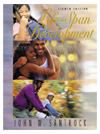 |  Life-Span Development, 8/e John W. Santrock,
University of Texas - Dallas
Late Adulthood Physical Development in Late Adulthood
Chapter ObjectivesI.Distinguish between life expectancy and life span, including mention of cross-cultural differences. |
 |  |  | II.Elaborate on the characteristics associated with being a centenarian. |
 |  |  | III.Describe the sex differences in longevity and what may account for them. |
 |  |  | IV.Be able to determine differences between the young old, the old old, and the oldest old. |
 |  |  | V.Discuss the biological theories of aging. |
 |  |  | VI.Elaborate on the course of physical development in late adulthood and the changes that take place in the brain as we age. |
 |  |  | VII.Indicate the physical and sensory changes that occur in the older adult. |
 |  |  | VIII.Discuss how sexual performance is impacted by aging. |
 |  |  | IX.Describe common health problems in late adulthood, and expound on the causes of death in older adults. |
 |  |  | X.Discuss arthritis and osteoporosis, including the symptoms, causes, and possible treatments for each. |
 |  |  | XI.Describe the robust oldest old. |
 |  |  | XII.Discuss the role of exercise, nutrition, and weigh in late adulthood, as well as the vitamin controversy. |
 |  |  | XIII.Explain care options for the elderly and ways to improve their care in the nursing home. |
 |  |  | XIV.Describe the relationship between health-care providers and the older adult. |
|



 2002 McGraw-Hill Higher Education
2002 McGraw-Hill Higher Education